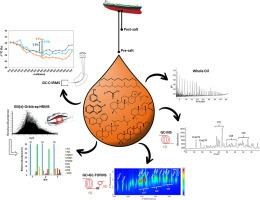当前位置:
X-MOL 学术
›
Org. Geochem.
›
论文详情
Our official English website, www.x-mol.net, welcomes your
feedback! (Note: you will need to create a separate account there.)
Deconvolution of post- and pre-salt petroleum sources in southeastern offshore Brazilian basins
Organic Geochemistry ( IF 2.6 ) Pub Date : 2020-11-01 , DOI: 10.1016/j.orggeochem.2020.104146 Thamara A. Barra , Clarisse L. Torres , Marco Aurélio Dal Sasso , Vinícius B. Pereira , Eugenio V. Santos Neto , Débora A. Azevedo
Organic Geochemistry ( IF 2.6 ) Pub Date : 2020-11-01 , DOI: 10.1016/j.orggeochem.2020.104146 Thamara A. Barra , Clarisse L. Torres , Marco Aurélio Dal Sasso , Vinícius B. Pereira , Eugenio V. Santos Neto , Débora A. Azevedo

|
Abstract The Campos, Santos and Espirito Santo Basins are part of the southeastern offshore Brazilian basins (SEOBB) where pre-salt reserves are located. This represents the most important oil province in Brazil. Constant growth in the discoveries and production of the country’s oil reserves has shown the importance of the pre-salt discoveries; thus, proper oil constituent characterization at the molecular level is needed for this type of petroleum. Six oils, collected in pre- and post-salt reservoirs from SEOBB, were evaluated using GC-FID, GC-MS, GC-C-IRMS, GC×GC-TOFMS, and ESI(±)-Orbitrap HRMS. The biomarker parameters obtained indicated a lacustrine input for all the oils, except for the TAB-4G post-salt oil. All the oils reached the peak of the oil generation window, except the TAB-4G oil, which reached the late stage. The carbon isotope profiles suggested a lacustrine depositional environment for the organic matter (OM); the δ13C isotopic amplitudes ranged from 3.2‰ to 6.9‰. The profile of the TAB-4G oil suggested a contribution from terrestrial OM. This work is one of the first to apply ESI(±)-Orbitrap HRMS for geochemical characterization. In both (±) ionization modes, the data showed that the oils had high percentages of Nx classes, especially N1 compounds, strengthening the interpretation of a lacustrine origin for the OM. ESI(-) HRMS showed that the TAB-4G oil contained a high relative percentage of Ox classes, especially O1 with the 8–16 double bond equivalent (DBE) species, suggesting a marine contribution. The combination of the conventional geochemical approach with advanced chromatographic and mass spectrometric techniques allowed for a comprehensive molecular characterization of the post- and pre-salt oils, contributing to a better understanding of the prolific SEOBB petroleum systems.
中文翻译:

巴西东南部近海盆地盐后和盐下油气资源的解卷积
摘要 Campos、Santos 和 Espirito Santo 盆地是巴西东南近海盆地 (SEOBB) 的一部分,这里有盐下储量。这是巴西最重要的石油产区。该国石油储量的发现和生产的不断增长表明了盐下发现的重要性;因此,这类石油需要在分子水平上进行适当的石油成分表征。使用 GC-FID、GC-MS、GC-C-IRMS、GC×GC-TOFMS 和 ESI(±)-Orbitrap HRMS 对在 SEOBB 的盐前和盐后油藏中收集的六种油进行了评估。获得的生物标志物参数表明除了 TAB-4G 盐后油之外的所有油都具有湖相输入。除TAB-4G油进入后期外,其余油类均达到生油窗口峰值。碳同位素剖面表明有机质 (OM) 为湖相沉积环境;δ13C 同位素振幅在 3.2‰ 到 6.9‰ 之间。TAB-4G 油的剖面表明来自陆地 OM 的贡献。这项工作是最早应用 ESI(±)-Orbitrap HRMS 进行地球化学表征的工作之一。在两种 (±) 电离模式中,数据显示油类 Nx 类的百分比很高,尤其是 N1 化合物,加强了对 OM 湖泊起源的解释。ESI(-) HRMS 显示 TAB-4G 油含有相对较高百分比的 Ox 类,尤其是具有 8-16 个双键当量 (DBE) 物种的 O1,表明海洋贡献。
更新日期:2020-11-01
中文翻译:

巴西东南部近海盆地盐后和盐下油气资源的解卷积
摘要 Campos、Santos 和 Espirito Santo 盆地是巴西东南近海盆地 (SEOBB) 的一部分,这里有盐下储量。这是巴西最重要的石油产区。该国石油储量的发现和生产的不断增长表明了盐下发现的重要性;因此,这类石油需要在分子水平上进行适当的石油成分表征。使用 GC-FID、GC-MS、GC-C-IRMS、GC×GC-TOFMS 和 ESI(±)-Orbitrap HRMS 对在 SEOBB 的盐前和盐后油藏中收集的六种油进行了评估。获得的生物标志物参数表明除了 TAB-4G 盐后油之外的所有油都具有湖相输入。除TAB-4G油进入后期外,其余油类均达到生油窗口峰值。碳同位素剖面表明有机质 (OM) 为湖相沉积环境;δ13C 同位素振幅在 3.2‰ 到 6.9‰ 之间。TAB-4G 油的剖面表明来自陆地 OM 的贡献。这项工作是最早应用 ESI(±)-Orbitrap HRMS 进行地球化学表征的工作之一。在两种 (±) 电离模式中,数据显示油类 Nx 类的百分比很高,尤其是 N1 化合物,加强了对 OM 湖泊起源的解释。ESI(-) HRMS 显示 TAB-4G 油含有相对较高百分比的 Ox 类,尤其是具有 8-16 个双键当量 (DBE) 物种的 O1,表明海洋贡献。









































 京公网安备 11010802027423号
京公网安备 11010802027423号